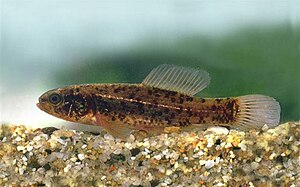European dogfish
| European dogfish | ||||||||||||
|---|---|---|---|---|---|---|---|---|---|---|---|---|

European dogfish ( Umbra krameri ) |
||||||||||||
| Systematics | ||||||||||||
|
||||||||||||
| Scientific name | ||||||||||||
| Umbra krameri | ||||||||||||
| Walbaum , 1792 |
The European dogfish ( Umbra krameri ), also called Hungarian dogfish , is the only European representative of the dogfish (Umbridae) and thus belongs to the order of the pike-like (Esociformes).
features
The European dogfish reaches a body length of 8 to 10 centimeters for the males and 13 centimeters for the females. It has an elongated, pike-like physique, which, however, as is typical for the dogfish, is somewhat stocky and only slightly flattened on the sides. The head is bluntly rounded. The head and body are covered with large round scales, which are also present on the gill covers . The dorsal fin has 15 to 16 rays, the pelvic fin 7 to 8.
The back and the flanks are brown to brown-red in color and have irregular dark spots, the back is usually darker than the sides of the body. On the side, the fish can also have a conspicuous, yellowish to copper-colored vertical line. The underside of the body is light yellowish to white. The dorsal fin is brownish and can be darkly speckled.
distribution
The European dogfish lives scattered in inland waters of Southeastern Europe in the catchment area of the Danube from Austria and Hungary via Slovakia to the Danube Delta in Romania . It can also be found in the lower reaches of the Dniester in the Odessa area .
In Austria the dog fish was since 1975 to be extinct, but was in 1992 by the biologist Thomas Spindler and Josef Wanzenböck in the Danube wetlands in the thread Bach between Orth an der Donau and Eckartsau rediscovered and successfully within the framework of breeding programs reintroduced in its original distribution area more spacious become. Occasionally the fish was also settled in Germany.
Way of life
The European dogfish lives in plant-rich and shallow waters with a muddy bottom, especially in pools , ditches, swamp waters and peat bogs . In order to adapt to the very often oxygen-poor waters , dogfish breathe atmospheric air in addition to the gills , which they absorb on the water surface and breathe through the swim bladder , which is connected to the intestine. The proportion of air breathing depends on the temporary water conditions and can account for up to 100% of total breathing in almost oxygen-free water.
The fish feed mainly on small crustaceans, insect larvae and fry. For locomotion, the pectoral and pelvic fins reach out, similar to the running motion of a horse at a gallop , while the dorsal fin flaps undulating. These unusual swimming movements allow the fish to ascend and descend horizontally and diagonally in the water.
The spawning season is February to April, during this time the females lay up to 400 eggs on aquatic plants or in self-dug pits beneath the roots and guard them until the young fish hatch. These hatch after six to ten days. The juvenile fish are very cannibalistic among themselves , so that very few fish survive in smaller pools. They are sexually mature after about two years.
Danger
Especially due to the extensive drainage of small bodies of water, the numbers of European dogfish are declining sharply in regions. However, the animals are not considered rare over the large total distribution area, so that the species is classified as vulnerable by the IUCN .
literature
- Günther Sterba : Freshwater fish in the world. 2nd Edition. Urania-Verlag, Leipzig et al. 1990, ISBN 3-332-00109-4 , p. 57 f.
- Andreas Vilcinskas : Fish. Central European freshwater species and marine fish from the North and Baltic Seas. BLV-Verlags-Gesellschaft, Munich 2000, ISBN 3-405-15848-6 , p. 122.
Web links
- Umbra krameri in the endangered Red List species the IUCN 2006. Posted by: World Conservation Monitoring Center, 1996. Accessed on 9 August, 2007.
- European dogfish on Fishbase.org (English)